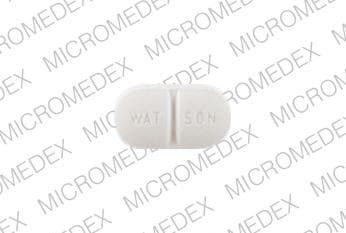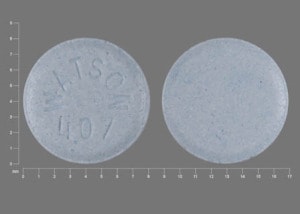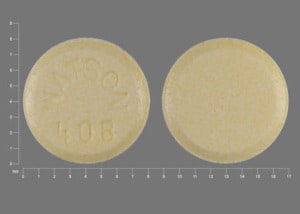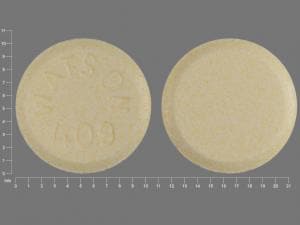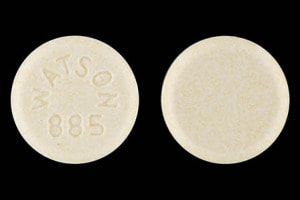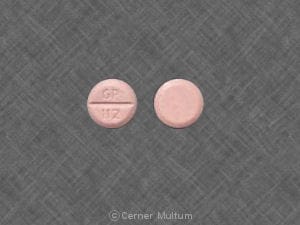Boxed Warning
Fetal toxicity:
When pregnancy is detected, discontinue lisinopril as soon as possible. Drugs that act directly on the renin-angiotensin system can cause injury and death to the developing fetus.
Dosage Forms
Excipient information presented when available (limited, particularly for generics); consult specific product labeling.
Solution, Oral:
Qbrelis: 1 mg/mL (150 mL) [contains sodium benzoate]
Tablet, Oral:
Prinivil: 5 mg, 10 mg, 20 mg [scored]
Zestril: 2.5 mg
Zestril: 5 mg [scored]
Zestril: 10 mg, 20 mg, 30 mg, 40 mg
Generic: 2.5 mg, 5 mg, 10 mg, 20 mg, 30 mg, 40 mg
Pharmacology
Mechanism of Action
Competitive inhibitor of angiotensin-converting enzyme (ACE); prevents conversion of angiotensin I to angiotensin II, a potent vasoconstrictor; results in lower levels of angiotensin II which causes an increase in plasma renin activity and a reduction in aldosterone secretion; a CNS mechanism may also be involved in hypotensive effect as angiotensin II increases adrenergic outflow from CNS; vasoactive kallikreins may be decreased in conversion to active hormones by ACE inhibitors, thus reducing blood pressure
Pharmacokinetics/Pharmacodynamics
Metabolism
Not metabolized
Excretion
Primarily urine (as unchanged drug)
Onset of Action
1 hour; Peak effect: Hypotensive: Oral: ~6 hours
Time to Peak
Pediatric patients 6 months to 15 years: Median (range): 5 to 6 hours (Hogg 2007)
Adults: ~7 hours
Duration of Action
24 hours
Half-Life Elimination
12 hours
Use in Specific Populations
Special Populations: Renal Function Impairment
Decreased elimination when glomerular filtration rate is <30 mL/minute. With greater impairment, peak and trough lisinopril levels increase, time to peak concentration increases, and time to attain steady state is prolonged.
Use: Labeled Indications
Heart failure with reduced ejection fraction: Adjunctive therapy to reduce signs and symptoms of systolic heart failure.
Hypertension: Management of hypertension in adult and pediatric patients ≥6 years of age.
ST-elevation myocardial infarction: Treatment of acute MI within 24 hours in hemodynamically stable patients to improve survival.
Use: Off Label
Non-ST-elevation acute coronary syndromeyes
Based on the 2014 American College of Cardiology/American Heart Association (ACC/AHA) guidelines for the management of patients with non-ST-elevation acute coronary syndromes (NSTE-ACS), an ACE inhibitor should be initiated and continued indefinitely after NSTE-ACS in patients with a left ventricular ejection fraction (LVEF) ≤40% and in those with hypertension, diabetes mellitus, or stable chronic kidney disease (CKD) unless contraindicated. Use of an ACE inhibitor may also be useful in all other patients with cardiac or other vascular disease.
Posttransplant erythrocytosis (renal transplant recipients)c
Data from a limited number of small clinical trials suggest that lisinopril may be beneficial for the treatment of renal transplant recipients who have posttransplant erythrocytosis Glicklich 2001, MacGregor 1996, Sauron 1993.
Proteinuric chronic kidney disease (diabetic or nondiabetic)yes
Based on the 2013 Kidney Disease Improving Global Outcomes (KDIGO) guidelines, the use of an ACE inhibitor or an angiotensin receptor blocker (ARB) is recommended in patients with proteinuric CKD to prevent progression of CKD.
Stable coronary artery diseaseyes
Based on the 2012 ACC/AHA guideline for the diagnosis and management of patients with stable ischemic heart disease, an ACE inhibitor or ARB should be prescribed in all patients with stable ischemic heart disease who also have hypertension, diabetes mellitus, LVEF <40%, or CKD unless contraindicated.
Contraindications
Hypersensitivity to lisinopril, other ACE inhibitors, or any component of the formulation; angioedema related to previous treatment with an ACE inhibitor; idiopathic or hereditary angioedema; concomitant use with aliskiren in patients with diabetes mellitus; coadministration with or within 36 hours of switching to or from a neprilysin inhibitor (eg, sacubitril).
Canadian labeling: Additional contraindications (not in US labeling): Women who are pregnant, intend to become pregnant, or of childbearing potential and not using adequate contraception; breastfeeding; concomitant use with aliskiren, angiotensin receptor blockers (ARBs), or other ACE inhibitors in patients with moderate to severe renal impairment (GFR <60 mL/minute/1.73 m2), hyperkalemia (>5 mmol/L), or with heart failure who are hypotensive; concomitant use with ARBs or other ACE inhibitors in diabetic patients with end organ damage; pediatric patients <6 years; pediatric patients 6 to 16 years of age with severe renal impairment (GFR <60 mL/minute/1.73 m2).
Dosage and Administration
Dosing: Adult
Acute coronary syndromes:
Non-ST-elevation acute coronary syndrome (off-label use):
Note: Patients should be hemodynamically stable before initiation. Use as a component of an appropriate medical regimen, which may also include antiplatelet agent(s), a beta-blocker, and a statin. Continue angiotensin-converting enzyme (ACE) inhibitor therapy indefinitely for patients with concurrent diabetes, left ventricular ejection fraction ≤40%, hypertension, or stable chronic kidney disease (AHA/ACC [Amsterdam 2014]). Dosing recommendations based on general dosing range in manufacturer's labeling.
Oral: Initial: 2.5 to 10 mg once daily (depending on initial blood pressure); titrate slowly based on tolerability and response up to 40 mg/day.
ST-elevation myocardial infarction:
Note: Patients should be hemodynamically stable before initiation. Use as a component of an appropriate medical regimen, which may also include antiplatelet agent(s), a beta-blocker, and a statin. Continue ACE inhibitor therapy indefinitely (ACCF/AHA [O'Gara 2013]). Dosing recommendations based on general dosing range in manufacturer's labeling.
Oral: Initial: 2.5 to 5 mg once daily initiated within 24 hours of presentation; titrate slowly up to 10 mg/day or higher as tolerated under close monitoring to avoid hypotension; maximum: 40 mg/day (ACCF/AHA [O'Gara 2013]; GISSI-3 1994; Reeder 2018).
Heart failure with reduced ejection fraction: Oral: Initial: 2.5 to 5 mg once daily; as tolerated, may increase every 1 to 2 weeks by no more than 10 mg increments to a target dose of 40 mg once daily according to the ACCF/AHA guidelines (ACCF/AHA [Yancy 2013]; Meyer 2019). In hospitalized patients, the dose may be titrated at 1- to 2-day intervals (Meyer 2019.
Hypertension:
Note: For initial treatment in patients with blood pressure ≥20/10 mm Hg above goal, may be used in combination with another appropriate agent (eg, long-acting dihydropyridine calcium channel blocker, thiazide diuretic). For patients <20/10 mm Hg above goal, some experts recommend an initial trial of monotherapy; however, over time, many patients will require combination therapy (ACC/AHA [Whelton 2018]; Mann 2018b).
Oral: Initial: 5 to 10 mg once daily; evaluate response every 4 to 6 weeks and titrate dose in 1-step increments (eg, increase the daily dose by doubling) as needed, up to 40 mg once daily (ACC/AHA [Whelton 2018]; Mann 2018b).
Posttransplant erythrocytosis (renal transplant recipients) (off-label use):
Note: For patients with a hemoglobin concentration >17 g/dL (Brennan 2019).
Oral: Initial: 2.5 or 5 mg once daily; if inadequate response seen within 4 weeks, may titrate up to 40 mg/day based on hemoglobin and blood pressure response; if hemoglobin remains >17 g/dL after an additional 4 weeks, consider additional therapy (eg, phlebotomy) (Brennan 2019; Glicklich 2001; MacGregor 1996; Sauron 1993).
Proteinuric chronic kidney disease (diabetic or nondiabetic) (off-label use): Dosing recommendations based on expert opinion and general dosing range in manufacturer's labeling:
Oral: Initial: 2.5 to 10 mg once daily depending on blood pressure; titrate slowly based on tolerability and response up to 40 mg/day. Target to an appropriate blood pressure goal and a proteinuria goal of <1 g/day (KDIGO 2013; Mann 2020).
IgA nephropathy: In addition to an appropriate blood pressure goal, a proteinuria goal of <1 g/day is also generally recommended (KDIGO 2012). Some experts treat to a proteinuria goal of <500 mg/day. If proteinuria goal is not met with monotherapy at the maximum dose, consider adding other modalities and/or agents (Cattran 2018).
Dosing: Geriatric
Refer to adult dosing. In the management of hypertension, consider lower initial doses (eg, 2.5 to 5 mg once daily) and titrate to response (Aronow 2011).
Dosing: Pediatric
Note: Compounded and commercially available oral solutions have multiple concentrations; precautions should be taken to verify and avoid confusion between the different concentrations; dose should be clearly presented as mg.
Hypertension: Note: Use lower listed initial dose in patients with hyponatremia, hypovolemia, severe CHF, decreased renal function, or in those receiving diuretics. Titrate dose according to patient's response.
Children <6 years: Limited data available: Oral: Initial: 0.07 mg/kg/dose once daily; maximum initial daily dose: 5 mg/day; maximum daily dose: 0.6 mg/kg/day or 40 mg/day (Flynn 2006)
Children ≥6 years and Adolescents: Oral: Initial: 0.07 mg/kg/dose once daily; maximum initial daily dose: 5 mg/day; maximum daily dose: 0.6 mg/kg/day or 40 mg/day
Proteinuria (eg, mild IgA nephropathy, focal segmental glomerulosclerosis [FSGS]): Limited data available: Children ≥2 years and Adolescents: Oral: Initial: 0.1 to 0.2 mg/kg/dose once daily; increase at 1- to 2-week intervals to target dose of 0.4 mg/kg/dose once daily (Gipson 2011; Nakanishi 2009); maximum dose: 40 mg/day. Dosing based on a prospective study (total patients: n=138; pediatric patients: n=93, age range: 2 to 17 years) in patients with steroid-resistant FSGS comparing mycophenolate to cyclosporine in which most patients received lisinopril (n=118) for protein sparing effects. Lisinopril was initiated at 0.1 mg/kg/dose and increased every 2 weeks to target dose of 0.4 mg/kg/dose (maximum dose: 40 mg/dose) (Gipson 2011). In pediatric patients with mild IgA nephropathy (n=40, mean age: 11.4 years; range: 4.4 to 15.4 years), a similar protocol was used, with an initial dose of 0.2 mg/kg/dose increased after 7 days to 0.4 mg/kg/dose (maximum dose: 20 mg/dose) (Nakanishi 2009).
Extemporaneously Prepared
Note: A lisinopril oral solution (1 mg/mL) is commercially available (Qbrelis).
1 mg/mL Oral Suspension
A 1 mg/mL lisinopril oral suspension may be made with tablets and a 1:1 mixture of Ora-Plus and Ora-Sweet. Crush ten 10 mg tablets in a mortar and reduce to a fine powder. Add small portions of the vehicle and mix to a uniform paste; mix while adding the vehicle in incremental proportions to almost 100 mL; transfer to a graduated cylinder; rinse mortar with vehicle, and add quantity of vehicle sufficient to make 100 mL. Store in amber plastic prescription bottles; label "shake well." Stable for 13 weeks at room temperature or refrigerated (Nahata 2004).
Nahata MC and Morosco RS. Stability of lisinopril in two liquid dosage forms. Ann Pharmacother. 2004;38(3):396-399.14742834
A 1 mg/mL lisinopril oral suspension may be made with tablets and a mixture of sodium citrate/citric acid oral solution or Cytra-2 diluent and Ora-Sweet SF. Place ten 20 mg tablets into an 8 ounce amber polyethylene terephthalate (PET) bottle and then add 10 mL purified water and shake for at least 1 minute. Gradually add 30 mL of sodium citrate/citric acid oral solution or Cytra-2 diluent and 160 mL of Ora-Sweet SF to the bottle and gently shake after each addition to disperse the contents. Store resulting suspension at ≤25°C (77°F) for up to 4 weeks. Label bottle “shake well” (Prinivil prescribing information 2016; Thompson 2003).
Prinivil (lisinopril) [prescribing information]. Whitehouse Station, NJ: Merck & Co., Inc; October 2016.Thompson KC, Zhao Z, Mazakas JM, et al. Characterization of an extemporaneous liquid formulation of lisinopril. Am J Health Syst Pharm. 2003;60(1):69-74.12533979
A 1 mg/mL lisinopril oral suspension also be made with tablets, methylcellulose 1% with parabens, and simple syrup NF. Crush ten 10 mg tablets in a mortar and reduce to a fine powder. Add 7.7 mL of methylcellulose gel and mix to a uniform paste; mix while adding the simple syrup in incremental proportions to almost 100 mL; transfer to a graduated cylinder; rinse mortar with vehicle, and add quantity of vehicle sufficient to make 100 mL. Store in amber plastic prescription bottles; label "shake well." Stable for 13 weeks refrigerated or 8 weeks at room temperature (Nahata 2004).
Nahata MC and Morosco RS. Stability of lisinopril in two liquid dosage forms. Ann Pharmacother. 2004;38(3):396-399.14742834
2 mg/mL Syrup
A 2 mg/mL lisinopril syrup may be made with powder (Sigma Chemical Company, St. Louis, MO) and simple syrup. Dissolve 1 g of lisinopril powder in 30 mL of distilled water. Mix while adding simple syrup in incremental proportions in a quantity sufficient to make 500 mL. Label "shake well" and "refrigerate." Stable for 30 days when stored in amber plastic prescription bottles at room temperature or refrigerated. Note: Although no visual evidence of microbial growth was observed, the authors recommend refrigeration to inhibit microbial growth (Webster 1997).
Webster AA, English BA, and Rose DJ. The stability of lisinopril as an extemporaneous syrup. Intr J Pharmaceut Compound. 1997;1:352-353.
Administration
Oral: Administer as a single daily dose and without regard to meals.
Dietary Considerations
Use potassium-containing salt substitutes cautiously in patients with diabetes, patients with renal impairment, or those maintained on potassium supplements or potassium-sparing diuretics.
Storage
Oral solution: Store at 20°C to 25°C (68°F to 77°F). Protect from freezing and excessive heat.
Tablet: Store at 15°C to 30°C (59°F to 86°F). Protect from moisture.
Lisinopril Images
Drug Interactions
Alfuzosin: May enhance the hypotensive effect of Blood Pressure Lowering Agents. Monitor therapy
Aliskiren: May enhance the hyperkalemic effect of Angiotensin-Converting Enzyme Inhibitors. Aliskiren may enhance the hypotensive effect of Angiotensin-Converting Enzyme Inhibitors. Aliskiren may enhance the nephrotoxic effect of Angiotensin-Converting Enzyme Inhibitors. Management: Aliskiren use with ACEIs or ARBs in patients with diabetes is contraindicated. Combined use in other patients should be avoided, particularly when CrCl is less than 60 mL/min. If combined, monitor potassium, creatinine, and blood pressure closely. Consider therapy modification
Allopurinol: Angiotensin-Converting Enzyme Inhibitors may enhance the potential for allergic or hypersensitivity reactions to Allopurinol. Consider therapy modification
Alteplase: Angiotensin-Converting Enzyme Inhibitors may enhance the adverse/toxic effect of Alteplase. Specifically, the risk for angioedema may be increased. Monitor therapy
Amifostine: Blood Pressure Lowering Agents may enhance the hypotensive effect of Amifostine. Management: When amifostine is used at chemotherapy doses, blood pressure lowering medications should be withheld for 24 hours prior to amifostine administration. If blood pressure lowering therapy cannot be withheld, amifostine should not be administered. Consider therapy modification
Amphetamines: May diminish the antihypertensive effect of Antihypertensive Agents. Monitor therapy
Angiotensin II: Angiotensin-Converting Enzyme Inhibitors may enhance the therapeutic effect of Angiotensin II. Monitor therapy
Angiotensin II Receptor Blockers: May enhance the adverse/toxic effect of Angiotensin-Converting Enzyme Inhibitors. Angiotensin II Receptor Blockers may increase the serum concentration of Angiotensin-Converting Enzyme Inhibitors. Management: In US labeling, use of telmisartan and ramipril is not recommended. It is not clear if any other combination of an ACE inhibitor and an ARB would be any safer. Consider alternatives to the combination when possible. Consider therapy modification
Antipsychotic Agents (Second Generation [Atypical]): Blood Pressure Lowering Agents may enhance the hypotensive effect of Antipsychotic Agents (Second Generation [Atypical]). Monitor therapy
Aprotinin: May diminish the antihypertensive effect of Angiotensin-Converting Enzyme Inhibitors. Monitor therapy
AzaTHIOprine: Angiotensin-Converting Enzyme Inhibitors may enhance the myelosuppressive effect of AzaTHIOprine. Monitor therapy
Barbiturates: May enhance the hypotensive effect of Blood Pressure Lowering Agents. Monitor therapy
Benperidol: May enhance the hypotensive effect of Blood Pressure Lowering Agents. Monitor therapy
Brigatinib: May diminish the antihypertensive effect of Antihypertensive Agents. Brigatinib may enhance the bradycardic effect of Antihypertensive Agents. Monitor therapy
Brimonidine (Topical): May enhance the hypotensive effect of Blood Pressure Lowering Agents. Monitor therapy
Bromperidol: Blood Pressure Lowering Agents may enhance the hypotensive effect of Bromperidol. Bromperidol may diminish the hypotensive effect of Blood Pressure Lowering Agents. Avoid combination
Dapoxetine: May enhance the orthostatic hypotensive effect of Angiotensin-Converting Enzyme Inhibitors. Monitor therapy
Dexmethylphenidate: May diminish the therapeutic effect of Antihypertensive Agents. Monitor therapy
Diazoxide: May enhance the hypotensive effect of Blood Pressure Lowering Agents. Monitor therapy
Dipeptidyl Peptidase-IV Inhibitors: May enhance the adverse/toxic effect of Angiotensin-Converting Enzyme Inhibitors. Specifically, the risk of angioedema may be increased. Monitor therapy
Drospirenone: Angiotensin-Converting Enzyme Inhibitors may enhance the hyperkalemic effect of Drospirenone. Monitor therapy
DULoxetine: Blood Pressure Lowering Agents may enhance the hypotensive effect of DULoxetine. Monitor therapy
Eplerenone: May enhance the hyperkalemic effect of Angiotensin-Converting Enzyme Inhibitors. Monitor therapy
Everolimus: May enhance the adverse/toxic effect of Angiotensin-Converting Enzyme Inhibitors. Specifically, the risk of angioedema may be increased. Monitor therapy
Ferric Gluconate: Angiotensin-Converting Enzyme Inhibitors may enhance the adverse/toxic effect of Ferric Gluconate. Monitor therapy
Ferric Hydroxide Polymaltose Complex: Angiotensin-Converting Enzyme Inhibitors may enhance the adverse/toxic effect of Ferric Hydroxide Polymaltose Complex. Specifically, the risk for angioedema or allergic reactions may be increased. Monitor therapy
Gelatin (Succinylated): Angiotensin-Converting Enzyme Inhibitors may enhance the adverse/toxic effect of Gelatin (Succinylated). Specifically, the risk of a paradoxical hypotensive reaction may be increased. Monitor therapy
Gold Sodium Thiomalate: Angiotensin-Converting Enzyme Inhibitors may enhance the adverse/toxic effect of Gold Sodium Thiomalate. An increased risk of nitritoid reactions has been appreciated. Monitor therapy
Grass Pollen Allergen Extract (5 Grass Extract): Angiotensin-Converting Enzyme Inhibitors may enhance the adverse/toxic effect of Grass Pollen Allergen Extract (5 Grass Extract). Specifically, ACE inhibitors may increase the risk of severe allergic reaction to Grass Pollen Allergen Extract (5 Grass Extract). Consider therapy modification
Heparin: May enhance the hyperkalemic effect of Angiotensin-Converting Enzyme Inhibitors. Monitor therapy
Heparins (Low Molecular Weight): May enhance the hyperkalemic effect of Angiotensin-Converting Enzyme Inhibitors. Monitor therapy
Herbs (Hypertensive Properties): May diminish the antihypertensive effect of Antihypertensive Agents. Monitor therapy
Herbs (Hypotensive Properties): May enhance the hypotensive effect of Blood Pressure Lowering Agents. Monitor therapy
Hypotension-Associated Agents: Blood Pressure Lowering Agents may enhance the hypotensive effect of Hypotension-Associated Agents. Monitor therapy
Icatibant: May diminish the antihypertensive effect of Angiotensin-Converting Enzyme Inhibitors. Monitor therapy
Iron Dextran Complex: Angiotensin-Converting Enzyme Inhibitors may enhance the adverse/toxic effect of Iron Dextran Complex. Specifically, patients receiving an ACE inhibitor may be at an increased risk for anaphylactic-type reactions. Management: Follow iron dextran recommendations closely regarding both having resuscitation equipment and trained personnel on-hand prior to iron dextran administration and the use of a test dose prior to the first therapeutic dose. Consider therapy modification
Lanthanum: May decrease the serum concentration of Angiotensin-Converting Enzyme Inhibitors. Management: Administer angiotensin-converting enzyme inhibitors at least two hours before or after lanthanum. Consider therapy modification
Levodopa-Containing Products: Blood Pressure Lowering Agents may enhance the hypotensive effect of Levodopa-Containing Products. Monitor therapy
Lithium: Angiotensin-Converting Enzyme Inhibitors may increase the serum concentration of Lithium. Management: Lithium dosage reductions will likely be needed following the addition of an ACE inhibitor. Monitor patient response to lithium closely following addition or discontinuation of concurrent ACE inhibitor treatment. Consider therapy modification
Loop Diuretics: May enhance the hypotensive effect of Angiotensin-Converting Enzyme Inhibitors. Loop Diuretics may enhance the nephrotoxic effect of Angiotensin-Converting Enzyme Inhibitors. Monitor therapy
Lormetazepam: May enhance the hypotensive effect of Blood Pressure Lowering Agents. Monitor therapy
Methylphenidate: May diminish the antihypertensive effect of Antihypertensive Agents. Monitor therapy
Molsidomine: May enhance the hypotensive effect of Blood Pressure Lowering Agents. Monitor therapy
Naftopidil: May enhance the hypotensive effect of Blood Pressure Lowering Agents. Monitor therapy
Nicergoline: May enhance the hypotensive effect of Blood Pressure Lowering Agents. Monitor therapy
Nicorandil: May enhance the hyperkalemic effect of Angiotensin-Converting Enzyme Inhibitors. Monitor therapy
Nicorandil: May enhance the hypotensive effect of Blood Pressure Lowering Agents. Monitor therapy
Nitroprusside: Blood Pressure Lowering Agents may enhance the hypotensive effect of Nitroprusside. Monitor therapy
Nonsteroidal Anti-Inflammatory Agents: Angiotensin-Converting Enzyme Inhibitors may enhance the adverse/toxic effect of Nonsteroidal Anti-Inflammatory Agents. Specifically, the combination may result in a significant decrease in renal function. Nonsteroidal Anti-Inflammatory Agents may diminish the antihypertensive effect of Angiotensin-Converting Enzyme Inhibitors. Monitor therapy
Obinutuzumab: May enhance the hypotensive effect of Blood Pressure Lowering Agents. Management: Consider temporarily withholding blood pressure lowering medications beginning 12 hours prior to obinutuzumab infusion and continuing until 1 hour after the end of the infusion. Consider therapy modification
Pentoxifylline: May enhance the hypotensive effect of Blood Pressure Lowering Agents. Monitor therapy
Pholcodine: Blood Pressure Lowering Agents may enhance the hypotensive effect of Pholcodine. Monitor therapy
Phosphodiesterase 5 Inhibitors: May enhance the hypotensive effect of Blood Pressure Lowering Agents. Monitor therapy
Potassium Salts: May enhance the hyperkalemic effect of Angiotensin-Converting Enzyme Inhibitors. Monitor therapy
Potassium-Sparing Diuretics: May enhance the hyperkalemic effect of Angiotensin-Converting Enzyme Inhibitors. Monitor therapy
Pregabalin: Angiotensin-Converting Enzyme Inhibitors may enhance the adverse/toxic effect of Pregabalin. Specifically, the risk of angioedema may be increased. Monitor therapy
Prostacyclin Analogues: May enhance the hypotensive effect of Blood Pressure Lowering Agents. Monitor therapy
Quinagolide: May enhance the hypotensive effect of Blood Pressure Lowering Agents. Monitor therapy
Racecadotril: May enhance the adverse/toxic effect of Angiotensin-Converting Enzyme Inhibitors. Specifically, the risk for angioedema may be increased with this combination. Monitor therapy
Ranolazine: May enhance the adverse/toxic effect of Angiotensin-Converting Enzyme Inhibitors. Monitor therapy
Sacubitril: Angiotensin-Converting Enzyme Inhibitors may enhance the adverse/toxic effect of Sacubitril. Specifically, the risk of angioedema may be increased with this combination. Avoid combination
Salicylates: May enhance the nephrotoxic effect of Angiotensin-Converting Enzyme Inhibitors. Salicylates may diminish the therapeutic effect of Angiotensin-Converting Enzyme Inhibitors. Monitor therapy
Sirolimus: May enhance the adverse/toxic effect of Angiotensin-Converting Enzyme Inhibitors. Monitor therapy
Sodium Phosphates: Angiotensin-Converting Enzyme Inhibitors may enhance the nephrotoxic effect of Sodium Phosphates. Specifically, the risk of acute phosphate nephropathy may be enhanced. Management: Consider avoiding this combination by temporarily suspending treatment with ACEIs, or seeking alternatives to oral sodium phosphate bowel preparation. If the combination cannot be avoided, maintain adequate hydration and monitor renal function closely. Consider therapy modification
Tacrolimus (Systemic): Angiotensin-Converting Enzyme Inhibitors may enhance the hyperkalemic effect of Tacrolimus (Systemic). Monitor therapy
Temsirolimus: May enhance the adverse/toxic effect of Angiotensin-Converting Enzyme Inhibitors. Monitor therapy
Thiazide and Thiazide-Like Diuretics: May enhance the hypotensive effect of Angiotensin-Converting Enzyme Inhibitors. Thiazide and Thiazide-Like Diuretics may enhance the nephrotoxic effect of Angiotensin-Converting Enzyme Inhibitors. Monitor therapy
TiZANidine: May enhance the hypotensive effect of Lisinopril. Monitor therapy
Tolvaptan: May enhance the hyperkalemic effect of Angiotensin-Converting Enzyme Inhibitors. Monitor therapy
Trimethoprim: May enhance the hyperkalemic effect of Angiotensin-Converting Enzyme Inhibitors. Monitor therapy
Urapidil: May interact via an unknown mechanism with Angiotensin-Converting Enzyme Inhibitors. Management: Avoid concomitant use of urapidil and angiotensin-converting enzyme (ACE) inhibitors. Consider therapy modification
Yohimbine: May diminish the antihypertensive effect of Antihypertensive Agents. Monitor therapy
Test Interactions
May lead to false-negative aldosterone/renin ratio (ARR) (Funder 2016)
Adverse Reactions
>10%:
Cardiovascular: Hypotension (4% to 11%)
Central nervous system: Dizziness (4% to 19%)
Renal: Increased serum creatinine (≤10%; transient), increased blood urea nitrogen (≤2%; transient)
1% to 10%:
Cardiovascular: Syncope (5% to 7%), chest pain (2% to 3%), flushing (≥1%), orthostatic effect (≥1%), vasculitis (≥1%)
Central nervous system: Headache (4% to 6%), altered sense of smell (≥1%), fatigue (≥1%), paresthesia (≥1%), vertigo (≥1%)
Dermatologic: Skin rash (≥1% to 2%), alopecia (≥1%), diaphoresis (≥1%), erythema (≥1%), pruritus (≥1%), skin photosensitivity (≥1%), Stevens-Johnson syndrome (≥1%), toxic epidermal necrolysis (≥1%), urticaria (≥1%)
Endocrine & metabolic: Hyperkalemia (2% to 6%), diabetes mellitus (≥1%), gout (≥1%), SIADH (≥1%)
Gastrointestinal: Diarrhea (≥1% to 4%), constipation (≥1%), dysgeusia (≥1%), flatulence (≥1%), pancreatitis (≥1%), xerostomia (≥1%)
Genitourinary: Impotence (≥1%)
Hematologic & oncologic: Bone marrow depression (≥1%), eosinophilia (≥1%), hemolytic anemia (≥1%), increased erythrocyte sedimentation rate (≥1%), leukocytosis (≥1%), leukopenia (≥1%), neutropenia (≥1%), positive ANA titer (≥1%), thrombocytopenia (≥1%; mean decrease of 0.4 mg/dL)
Neuromuscular & skeletal: Arthralgia (≥1%), arthritis (≥1%), myalgia (≥1%), weakness (≥1%)
Ophthalmic: Blurred vision (≥1%), diplopia (≥1%), photophobia (≥1%), vision loss (≥1%)
Otic: Tinnitus (≥1%)
Renal: Renal insufficiency (in patients with acute myocardial infarction: 1% to 2%)
Respiratory: Cough (3% to 4%)
Frequency not defined:
Hematologic & oncologic: Decreased hematocrit, decreased hemoglobin (mean decrease of 1.3%)
Hepatic: Increased liver enzymes, increased serum bilirubin
<1%, postmarketing, and/or case reports: Acute renal failure, angioedema, confusion, cutaneous pseudolymphoma, dehydration, fever, hallucination, hypoglycemia (diabetic patients on oral antidiabetic agents or insulin), hyponatremia, mood changes (including depressive symptoms), psoriasis, visual hallucination
Warnings/Precautions
Concerns related to adverse effects:
- Angioedema: At any time during treatment (especially following first dose), angioedema may occur rarely with ACE inhibitors; it may involve the head and neck (potentially compromising airway) or the intestine (presenting with abdominal pain). Black patients may be at an increased risk. Risk may also be increased with concomitant use of mTOR inhibitor (eg, everolimus) therapy or a neprilysin inhibitor (eg, sacubitril). Prolonged frequent monitoring may be required especially if tongue, glottis, or larynx are involved as they are associated with airway obstruction. Patients with a history of airway surgery may have a higher risk of airway obstruction. Aggressive early and appropriate management is critical. Use in patients with idiopathic or hereditary angioedema or previous angioedema associated with ACE inhibitor therapy is contraindicated.
- Cholestatic jaundice: A rare toxicity associated with ACE inhibitors includes cholestatic jaundice or hepatitis, which may progress to fulminant hepatic necrosis (some fatal); discontinue if marked elevation of hepatic transaminases or jaundice occurs.
- Cough: An ACE inhibitor cough is a dry, hacking, nonproductive one that usually occurs within the first few months of treatment and should generally resolve within 1 to 4 weeks after discontinuation of the ACE inhibitor. Other causes of cough should be considered (eg, pulmonary congestion in patients with heart failure) and excluded prior to discontinuation.
- Hematologic effects: Another ACE Inhibitor, captopril, has been associated with neutropenia with myeloid hypoplasia and agranulocytosis; anemia and thrombocytopenia have also occurred. Patients with renal impairment are at high risk of developing neutropenia. Patients with both renal impairment and collagen vascular disease (eg, systemic lupus erythematosus) are at an even higher risk of developing neutropenia. Periodically monitor CBC with differential in these patients.
- Hyperkalemia: May occur with ACE inhibitors; risk factors include renal impairment, diabetes mellitus, concomitant use of potassium-sparing diuretics, potassium supplements and/or potassium containing salts. Use cautiously, if at all, with these agents and monitor potassium closely.
- Hypersensitivity reactions: Anaphylactic/anaphylactoid reactions can occur with ACE inhibitors. Severe anaphylactoid reactions may be seen during hemodialysis (eg, CVVHD) with high-flux dialysis membranes (eg, AN69), and rarely, during low density lipoprotein apheresis with dextran sulfate cellulose. Rare cases of anaphylactoid reactions have been reported in patients undergoing sensitization treatment with hymenoptera (bee, wasp) venom while receiving ACE inhibitors.
- Hypotension/syncope: Symptomatic hypotension with or without syncope can occur with ACE inhibitors (usually with the first several doses). Effects are most often observed in volume-depleted patients; correct volume depletion prior to initiation. Close monitoring of patients is required especially within the first few weeks of initial dosing and with dosing increases; blood pressure must be lowered at a rate appropriate for the patient's clinical condition. Although dose reduction may be necessary, hypotension is not a reason for discontinuation of future ACE inhibitor use especially in patients with heart failure where a reduction in systolic blood pressure is a desirable observation. Avoid use in hemodynamically unstable patients after acute MI.
- Renal function deterioration: May be associated with deterioration of renal function and/or increases in BUN and serum creatinine, particularly in patients with low renal blood flow (eg, renal artery stenosis, heart failure) whose glomerular filtration rate (GFR) is dependent on efferent arteriolar vasoconstriction by angiotensin II; deterioration may result in oliguria, acute renal failure, and progressive azotemia. Small benign increases in serum creatinine may occur following initiation; consider discontinuation only in patients with progressive and/or significant deterioration in renal function (Bakris 2000).
Disease-related concerns:
- Aortic stenosis: Use with caution in patients with severe aortic stenosis; may reduce coronary perfusion resulting in ischemia.
- Ascites: Avoid use in patients with ascites due to cirrhosis or refractory ascites; if use cannot be avoided in patients with ascites due to cirrhosis, monitor blood pressure and renal function carefully to avoid rapid development of renal failure (AASLD [Runyon 2012]).
- Cardiovascular disease: Initiation of therapy in patients with ischemic heart disease or cerebrovascular disease warrants close observation due to the potential consequences posed by falling blood pressure (eg, MI, stroke). Fluid replacement, if needed, may restore blood pressure; therapy may then be resumed. Discontinue therapy in patients whose hypotension recurs.
- Collagen vascular disease: Use with caution in patients with collagen vascular disease especially with concomitant renal impairment; may be at increased risk for hematologic toxicity.
- Hepatic impairment: Use with caution in patients with hepatic impairment; consider baseline LFTs prior to initiating therapy.
- Hypertrophic cardiomyopathy (HCM) with outflow tract obstruction: Use with caution in patients with HCM and outflow tract obstruction since reduction in afterload may worsen symptoms associated with this condition (ACCF/AHA [Gersh 2011]).
- Renal artery stenosis: Use with caution in patients with unstented unilateral/bilateral renal artery stenosis. When unstented bilateral renal artery stenosis is present, use is generally avoided due to the elevated risk of deterioration in renal function unless possible benefits outweigh risks.
- Renal impairment: Use with caution in preexisting renal insufficiency; dosage adjustment may be needed. Avoid rapid dosage escalation which may lead to further renal impairment. In a retrospective cohort study of elderly patients (≥65 years of age) with MI and impaired left ventricular function, administration of an ACE inhibitor was associated with a survival benefit, including patients with serum creatinine concentrations >3 mg/dL (265 micromol/L) (Frances 2000).
Concurrent drug therapy issues:
- Drug-drug interactions: Potentially significant interactions may exist, requiring dose or frequency adjustment, additional monitoring, and/or selection of alternative therapy. Consult drug interactions database for more detailed information.
Dosage form specific issues:
- Benzyl alcohol and derivatives: Oral solution: Some dosage forms may contain sodium benzoate/benzoic acid; benzoic acid (benzoate) is a metabolite of benzyl alcohol; large amounts of benzyl alcohol (≥99 mg/kg/day) have been associated with a potentially fatal toxicity ("gasping syndrome") in neonates; the "gasping syndrome" consists of metabolic acidosis, respiratory distress, gasping respirations, CNS dysfunction (including convulsions, intracranial hemorrhage), hypotension, and cardiovascular collapse (AAP ["Inactive" 1997]; CDC 1982). Some data suggest that benzoate displaces bilirubin from protein-binding sites (Ahlfors 2001); avoid or use dosage forms containing benzyl alcohol derivative with caution in neonates. See manufacturer's labeling.
Special populations:
- Black patients: ACE inhibitors effectiveness is less in black patients than in non-black patients. In addition, ACE inhibitors cause a higher rate of angioedema in black than in non-black patients.
- Pregnancy: [US Boxed Warning]: Drugs that act on the renin-angiotensin system can cause injury and death to the developing fetus. Discontinue as soon as possible once pregnancy is detected.
- Surgical patients: In patients on chronic ACE inhibitor therapy, intraoperative hypotension may occur with induction and maintenance of general anesthesia; use with caution before, during, or immediately after major surgery. Cardiopulmonary bypass, intraoperative blood loss, or vasodilating anesthesia increases endogenous renin release. Use of ACE inhibitors perioperatively will blunt angiotensin II formation and may result in hypotension. However, discontinuation of therapy prior to surgery is controversial. If continued preoperatively, avoidance of hypotensive agents during surgery is prudent (Hillis 2011). Based on current research and clinical guidelines in patients undergoing noncardiac surgery, continuing ACE inhibitors is reasonable in the perioperative period. If ACE inhibitors are held before surgery, it is reasonable to restart postoperatively as soon as clinically feasible (ACC/AHA [Fleisher 2014]).
Monitoring Parameters
Blood pressure, heart rate; BUN, serum creatinine, and potassium; consider baseline LFTs (if preexisting hepatic impairment); monitor for jaundice or signs of hepatic failure; if patient has collagen vascular disease and/or renal impairment, periodically monitor CBC with differential.
Heart failure: Within 1 to 2 weeks after initiation and periodically thereafter, reassess renal function and serum potassium especially in patients with preexisting hypotension, hyponatremia, diabetes mellitus, azotemia, or those taking potassium supplements (ACCF/AHA [Yancy 2013]).
Hypertension: The 2017 Guideline for the Prevention, Detection, Evaluation, and Management of High Blood Pressure in Adults (ACC/AHA [Whelton 2018]):
Confirmed hypertension and known CVD or 10-year ASCVD risk ≥10%: Target blood pressure <130/80 mm Hg is recommended
Confirmed hypertension without markers of increased ASCVD risk: Target blood pressure <130/80 mm Hg may be reasonable
Diabetes and hypertension: The American Diabetes Association (ADA) guidelines (ADA 2019):
Patients 18 to 65 years of age, without ASCVD, and 10-year ASCVD risk <15%: Target blood pressure <140/90 mm Hg is recommended
Patients 18 to 65 years of age and known ASCVD or 10-year ASCVD risk >15%: Target blood pressure <130/80 mm Hg may be appropriate if it can be safely attained
Patients >65 years of age (healthy or complex/intermediate health): Target blood pressure <140/90 mm Hg is recommended
Patients >65 years of age (very complex/poor health): Target blood pressure <150/90 mm Hg is recommended
Pregnancy
Pregnancy Considerations
Lisinopril crosses the placenta (Bhatt-Mehta 1993; Filler 2003).
Exposure to an angiotensin-converting enzyme (ACE) inhibitor during the first trimester of pregnancy may be associated with an increased risk of fetal malformations (ACOG 203 2019; ESC [Regitz-Zagrosek 2018]); however, outcomes observed may also be influenced by maternal disease (ACC/AHA [Whelton 2017]).
[US Boxed Warning]: Drugs that act on the renin-angiotensin system can cause injury and death to the developing fetus. Discontinue as soon as possible once pregnancy is detected.
Drugs that act on the renin-angiotensin system are associated with oligohydramnios. Oligohydramnios, due to decreased fetal renal function, may lead to fetal lung hypoplasia and skeletal malformations. The use of these drugs in pregnancy is also associated with anuria, hypotension, renal failure, skull hypoplasia, and death in the fetus/neonate. Infants exposed to an ACE inhibitor in utero should be monitored for hyperkalemia, hypotension, and oliguria. Oligohydramnios may not appear until after irreversible fetal injury has occurred. Exchange transfusions or dialysis may be required to reverse hypotension or improve renal function, although data related to the effectiveness in neonates is limited.
Chronic maternal hypertension is also associated with adverse events in the fetus/infant. Chronic maternal hypertension may increase the risk of birth defects, low birth weight, premature delivery, stillbirth, and neonatal death. Actual fetal/neonatal risks may be related to duration and severity of maternal hypertension. Untreated chronic hypertension may also increase the risks of adverse maternal outcomes, including gestational diabetes, pre-eclampsia, delivery complications, stroke and myocardial infarction (ACOG 203 2019).
When treatment of hypertension in pregnancy is indicated, ACE inhibitors should generally be avoided due to their adverse fetal events; use in pregnant women should only be considered for cases of hypertension refractory to other medications (ACOG 203 2019). ACE inhibitors are not recommended for the treatment of heart failure in pregnancy (Regitz-Zagrosek [ESC 2018]).
ACE inhibitors should be avoided in sexually active females of reproductive potential not using effective contraception (ADA 2020). ACE inhibitors should generally be avoided for the treatment of hypertension in women planning a pregnancy; use should only be considered for cases of hypertension refractory to other medications (ACOG 203 2019).
Patient Education
What is this drug used for?
- It is used to treat high blood pressure.
- It is used to help heart function after a heart attack.
- It is used to treat heart failure (weak heart).
- It may be given to you for other reasons. Talk with the doctor.
Frequently reported side effects of this drug
- Headache
Other side effects of this drug: Talk with your doctor right away if you have any of these signs of:
- Kidney problems like unable to pass urine, blood in the urine, change in amount of urine passed, or weight gain.
- Liver problems like dark urine, fatigue, lack of appetite, nausea, abdominal pain, light-colored stools, vomiting, or yellow skin.
- High potassium like abnormal heartbeat, confusion, dizziness, passing out, weakness, shortness of breath, numbness or tingling feeling.
- Infection
- Severe dizziness
- Passing out
- Persistent cough
- Severe abdominal pain
- Severe nausea
- Vomiting
- Chest pain
- Signs of a significant reaction like wheezing; chest tightness; fever; itching; bad cough; blue skin color; seizures; or swelling of face, lips, tongue, or throat.
Note: This is not a comprehensive list of all side effects. Talk to your doctor if you have questions.
Consumer Information Use and Disclaimer: This information should not be used to decide whether or not to take this medicine or any other medicine. Only the healthcare provider has the knowledge and training to decide which medicines are right for a specific patient. This information does not endorse any medicine as safe, effective, or approved for treating any patient or health condition. This is only a brief summary of general information about this medicine. It does NOT include all information about the possible uses, directions, warnings, precautions, interactions, adverse effects, or risks that may apply to this medicine. This information is not specific medical advice and does not replace information you receive from the healthcare provider. You must talk with the healthcare provider for complete information about the risks and benefits of using this medicine.
